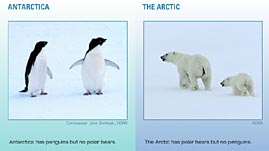Teachers' Domain - Digital Media for the Classroom and Professional Development
User: Preview

Source: Woods Hole Oceanographic Institution



In this interactive activity adapted from the Woods Hole Oceanographic Institution, compare characteristics of the Arctic and the Antarctic. Explore differences in physical features, weather, plants, wildlife, and human impact.
Many people know that Earth's polar regions, which exist at the north and south extremes of the planet, are both icy, cold places. However, the Arctic and the Antarctic actually differ in significant ways. For instance, the North Pole has no set landmass; the Arctic is an ocean, covered by ice and surrounded by land (notably Alaska, Canada, Greenland, Iceland, Norway, and Russia). In contrast, the South Pole is located on the continent of Antarctica, marked ceremonially by an actual pole; the Antarctic is land surrounded by water (the Southern Ocean).
There are differences in the types of ice found at the poles, as well. For example, while both regions have glaciers, the Antarctic has far more glacial ice than the Arctic; massive glaciers, called ice sheets, cover Antarctica and contain about 85 percent of the world's ice. Differences in ocean currents and winds also influence the patterns of sea ice formation. For example, Antarctic sea ice is fairly symmetric around the continent because the ocean currents and winds flow freely there. In contrast, some parts of the Arctic have more sea ice than others because there are variations in currents and winds along the different coasts. In addition, while both poles experience winter growth of sea ice, most Antarctic sea ice melts away in the summer because it can float to warmer waters. However, because the Arctic Ocean is nearly enclosed by land, the sea ice that forms there is relatively thick and does not completely melt each year. As a result, the central Arctic is always covered in sea ice, known as multiyear or perennial ice. In recent years, however, there has been a significant reduction in Arctic ice cover, and there have been openings in the perennial ice at the North Pole.
Regional geography makes the Antarctic colder than the Arctic. Water near the surface of the ocean never gets much colder than about –2°C (the temperature at which sea water freezes), which is relatively warm compared to the average air temperatures. Arctic sea ice is not more than a few meters thick, and so heat from the ocean can easily travel through the ice to the air. However, this heating effect is much less significant through the landmass of Antarctica. In addition, air temperature decreases as altitude increases. This does not affect the Arctic, which is at sea level, but because Antarctica has an average elevation of about 2,300 meters, there is a significant decrease in temperature due to elevation.
The relatively warm temperatures of the Arctic support a variety of plants and wildlife: shrubs and other vegetation grow on the Arctic tundra, and marine and bird life are active. In addition, because the surrounding land allows animals to migrate, the Arctic has a great diversity of land mammals such as caribou, fox, hare, wolf, and polar bears. Approximately four million people live in the Arctic, including indigenous cultures that subsist on the land and sea. In contrast, while the Antarctic supports marine and bird life, there is no vegetation, the largest animal that lives solely on land is the midge (a fly no more than a few millimeters long), and the only people are visiting research scientists.
 Loading Standards
Loading Standards Teachers' Domain is proud to be a Pathways portal to the National Science Digital Library.
Teachers' Domain is proud to be a Pathways portal to the National Science Digital Library.
